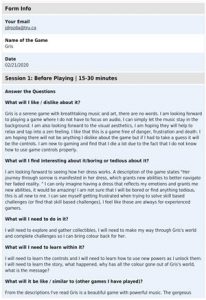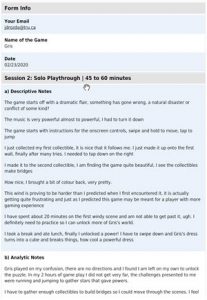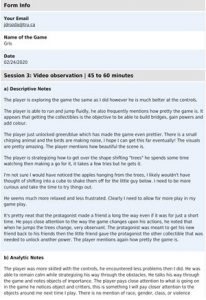The course calendar is broken down by the different phases of a typical university semester. I have added artifacts from my time in the MET program in hopes that they will inspire you to be creative with technology and more importantly encourage your students to be creative with technology at the corresponding phase in your semester.
Pre-semester
Before the semester starts think about creating online tools to help students organize and reflect on their learning. Click on the images below to see field notes I produced based on criteria outlined by my instructors. To provide us with the online logging forms the instructors used Gravity forms in WordPress. (I can help you with this!) The goal of this assignment was to create an empirically-driven, theoretically-grounded analysis of the game based solidly on evidence documented in the fieldnotes. Click on each of the thumbnails below to view my fieldnotes, they will open in a new tab.
Click here to view my submission.
Semester start
The start of the semester is a great time to dive into H5P. H5P is a simple way to build HTML5 learning objects! You may want to consider creating H5P objects for formative assessments, better yet start playing with H5P so you can have your students create them. Did you know we have our own instance of WordPress that includes an H5P plugin? View the interactive video and branching scenario created by myself and Melanie!
Midterm
Midway through the semester is a great time for students to show their learning. Why not have them create authentic assessments in the open? authentic assessments are assignments that are meaningful beyond the classroom and can be openly published. These types of assignments are not only publishable, students can use them to as artifacts in their portfolios and resumes. The artifacts below are published on not only my websites but my group partners as well. They were authored midway through the semester.
End of Semester
Let’s carry on with the theme of authentic assessments and get students authoring in the open. What do we mean by “open”? We are referring to any space that can be accessed by anyone outside the institution. When students work in the open the public can view their content and even comment on it. This creates an element of risk which promotes life-long learning.
To promote life-long learning, instructors need to encourage students to understand and experience an element of risk… In the classroom, this means that instructors need to create an environment that not only encourages risk-taking in learning, but values it. (Boesch, Reynolds, & Patton, 2015, p. 456)
Poke around at the following examples and see how students can display their learning when they are tasked with authentic assessments.
Math Lab – Curriculum User Guide ~ Check out the unit of learning my group created, a URL to their Moodle site and login instructions are found on the Math Lab in Moodle page.
Seven Elements of Art – A Digital Design and Development Project ~ This website provides a page for each of the 7 elements of art along with a form students can fill out to upload a picture of their own artwork, and then see that artwork displayed alongside the artist on their “maps” page.
First Peoples Principles of Learning ~ FPPL can provide educators with a holistic and practical pedagogical foundation from which to engage both Indigenous and non-Indigenous learners. Explore this my groups resource that is designed to provide BC educators with a greater understanding of the history and structure of the First Peoples Principles of Learning and why it is valuable.
Time to Twine ~ Twine is a tool for building text-based games. Take a look at how my group took this text-based platform and turned it into a media-based game to demonstrate their understanding of the readings.



